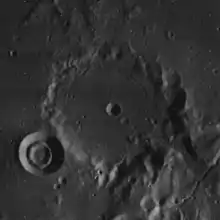Hesiodus (crater)
Hesiodus is a lunar impact crater located on the southern fringes of Mare Nubium, to the northwest of the crater Pitatus. It was named after the ancient Greek poet Hesiod.[1] Starting near the northwest rim of Hesiodus is the wide cleft named Rima Hesiodus. This rille runs 300 km east-southeastward to the Palus Epidemiarum
 Lunar Orbiter 4 image, with Hesiodus A at lower left | |
| Coordinates | 29.4°S 16.3°W |
|---|---|
| Diameter | 43 km |
| Depth | 1.4 km |
| Colongitude | 16° at sunrise |
| Eponym | Hesiod |
.png.webp)
The low rim of Hesiodus is heavily worn, with the southwest rim being slightly intruded upon by Hesodius A. The latter is an unusual circular crater with a concentric inner wall. To the southeast, a cleft in the wall of Hesiodus joins the crater to Pitatus.
Inside Hesiodus, the floor is flooded and relatively flat. It lacks a central peak, and, instead, a small impact crater Hesiodus D lies at the middle.
Satellite craters
By convention these features are identified on lunar maps by placing the letter on the side of the crater midpoint that is closest to Hesiodus.
| Hesiodus | Latitude | Longitude | Diameter |
|---|---|---|---|
| A | 30.1° S | 17.0° W | 15 km |
| B | 27.1° S | 17.5° W | 10 km |
| D | 29.3° S | 16.4° W | 5 km |
| E | 27.8° S | 15.3° W | 3 km |
| X | 27.3° S | 16.2° W | 24 km |
| Y | 28.3° S | 17.2° W | 17 km |
| Z | 28.7° S | 19.4° W | 4 km |
See also
- Hesiod (crater) - on Mercury
References
- "Hesiodus (crater)". Gazetteer of Planetary Nomenclature. USGS Astrogeology Research Program.
- Andersson, L. E.; Whitaker, E. A. (1982). NASA Catalogue of Lunar Nomenclature. NASA RP-1097.
- Bussey, B.; Spudis, P. (2004). The Clementine Atlas of the Moon. New York: Cambridge University Press. ISBN 978-0-521-81528-4.
- Cocks, Elijah E.; Cocks, Josiah C. (1995). Who's Who on the Moon: A Biographical Dictionary of Lunar Nomenclature. Tudor Publishers. ISBN 978-0-936389-27-1.
- McDowell, Jonathan (July 15, 2007). "Lunar Nomenclature". Jonathan's Space Report. Retrieved 2007-10-24.
- Menzel, D. H.; Minnaert, M.; Levin, B.; Dollfus, A.; Bell, B. (1971). "Report on Lunar Nomenclature by the Working Group of Commission 17 of the IAU". Space Science Reviews. 12 (2): 136–186. Bibcode:1971SSRv...12..136M. doi:10.1007/BF00171763.
- Moore, Patrick (2001). On the Moon. Sterling Publishing Co. ISBN 978-0-304-35469-6.
- Price, Fred W. (1988). The Moon Observer's Handbook. Cambridge University Press. ISBN 978-0-521-33500-3.
- Rükl, Antonín (1990). Atlas of the Moon. Kalmbach Books. ISBN 978-0-913135-17-4.
- Webb, Rev. T. W. (1962). Celestial Objects for Common Telescopes (6th revised ed.). Dover. ISBN 978-0-486-20917-3.
- Whitaker, Ewen A. (1999). Mapping and Naming the Moon. Cambridge University Press. ISBN 978-0-521-62248-6.
- Wlasuk, Peter T. (2000). Observing the Moon. Springer. ISBN 978-1-85233-193-1.
External links
| Wikimedia Commons has media related to Hesiodus (crater). |
- Hesiodus at the-moon.wikispaces.com
- Nemiroff, R.; Bonnell, J., eds. (27 March 2010). "Hesiodus Sunrise Ray". Astronomy Picture of the Day. NASA.